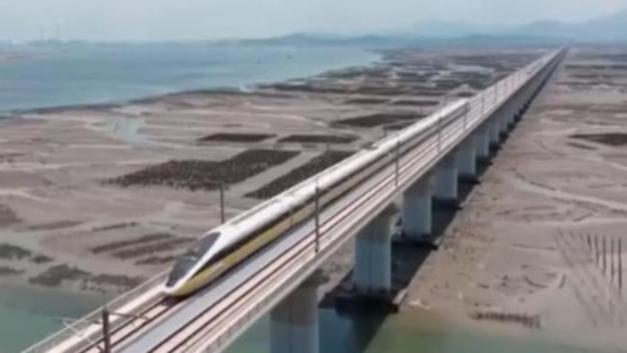At 10, Belt and Road cooperation remains buoyant

This photo taken on Oct. 17, 2023 shows a decoration for the third Belt and Road Forum for International Cooperation near the China National Convention Center in Beijing, capital of China. (Xinhua/Chen Bin)
By identifying growth bottlenecks and leveraging comparative strengths, the BRI has built a network to close divides and unleash development potential, with the zeitgeist of fostering a global community with a shared future.
by Xinhua writer Wang Xinyi
BEIJING, Oct. 17 (Xinhua) -- Saudi Arabia recently made Mandarin mandatory in all secondary schools, public and private, a groundbreaking leap for the leading Arab country in the Middle East.
Behind this learning boom for the Chinese language is Saudi Arabia's growing interest in forging economic links with China, as the two countries continue to synergize their development strategies under the Belt and Road Initiative (BRI), which turns 10 years old this year.
The kingdom was the largest recipient of BRI investments in the first half of 2022. Earlier this year, the two partners launched a joint venture in building an integrated refinery and petrochemical complex for fine chemicals and raw materials under the multi-trillion dollar initiative. Beyond green energy, they are exploring the potential of the circular carbon economy and digital infrastructure.
For Saudi Arabia and many other BRI participating countries, China is a genuine partner to support their nation-building projects and critical infrastructure.
The initiative seeks to turn land-locked economies into land-linked ones. With 19 million passengers and 24 million tonnes of freight delivered so far and its cross-border cargo transport covering over 10 countries and regions, the 1,035-km China-Laos Railway is a game changer for the people of Laos, facilitating trade, attracting investments and reviving tourism.
In rural Kenya, the Mombasa-Nairobi Standard Gauge Railway, another flagship BRI project in Africa, empowers young people with multifaceted skill sets.

Children wait to board a train at the Nairobi Station of the Mombasa-Nairobi Railway in Nairobi, Kenya, Oct. 6, 2023. (Xinhua/Wang Guansen)
Chinese development financing is recipient-driven, as "infrastructure projects are determined by the recipient country, not China, based on their own economic and political interests," the Liberation News observed.
China often advances loans at reasonably low interest rates, and Chinese banks are willing to restructure the terms of existing loans to be more favorable to the borrowing country, according to The Atlantic.
"Also, the BRI does not have a set of broad ideological conditions which countries must adhere to in order to participate. Technically, that means that model allows countries to develop projects with China that are specific to their needs," said Annita Montoute, acting director of the Institute of International Relations at the University of the West Indies in Trinidad and Tobago.
That's why this initiative is a boon for many low- and middle-income countries, particularly those in the Global South. Rich countries often brand them as high-risk-low-reward and impose onerous conditions, delaying project implementation and increasing costs.
"Chinese loans are more flexible and do not include any non-loan conditions," and the funds commonly flow into "real assets that increase the value of the real economy," Sri Lankan economist Kasun Kariyawasam told Xinhua.
During the COVID-19 pandemic, existing infrastructure helped to stabilize international industrial and supply chains. A direct line linking north-central China's Henan province with Luxemburg delivered unimpeded air and freighting services, transporting many critical supplies and functioning as a lifeline between China and Europe.
Despite internal dynamics in some countries and the COVID-19 pandemic, most BRI projects continued against the odds.
In Sri Lanka and Malaysia, "the most controversial BRI projects were initiated by the recipient governments, which pursued their own domestic agendas," observed the Chatham House, a London-based policy institute, in a report.
But what about the issue of country indebtedness?
"Their debt problems arose mainly from the misconduct of local elites and Western-dominated financial markets," it suggested, referring to the Hambantota Port, which turned out to be a "white elephant."
"When the U.S. Federal Reserve began to taper its quantitative easing program, suddenly Sri Lanka's cost of borrowing increased, forcing it to seek International Monetary Fund assistance," Shahar Hameiri, associate professor of international politics at the University of Queensland, wrote in an analysis published by the Lowy Institute, an Australian think tank.
"Never attribute to malice what can be explained by incompetence," he said, debunking the myth of China ensnaring recipient countries with unsustainable debt propagated by certain Western countries, who either lost the bids or were blinded by geopolitical calculations.
As a global public good amid shifting international dynamics, the BRI is not static but progressive and reformative. Over the years, it has expanded to cover more countries and become enriched with new meanings.

A China-Europe freight train loaded with raw materials of liquorice, a Chinese medicinal herb, which departed from Turkmenistan, arrives at Xi'an international port in Xi'an, northwest China's Shaanxi Province, Aug. 31, 2022. (Xinhua/Liu Xiao)
Built upon experience, China has been recalibrating its megaprojects overseas, working increasingly closely with recipient countries on their design, feasibility, selection, pricing, tendering and management to increase profitability and guarantee a smooth operation.
What underpins such collaboration is commensurate legal mechanisms and regulations that continuously improve to deliver high-quality, sustainable, risk-resistant, reasonably priced and inclusive infrastructure.
By identifying growth bottlenecks and leveraging comparative strengths, the BRI has built a network to close divides and unleash development potential, with the zeitgeist of fostering a global community with a shared future.
Ten years and counting, and through collaboration and mutual understanding, the sky is the limit for such a dynamic paradigm of international cooperation.






